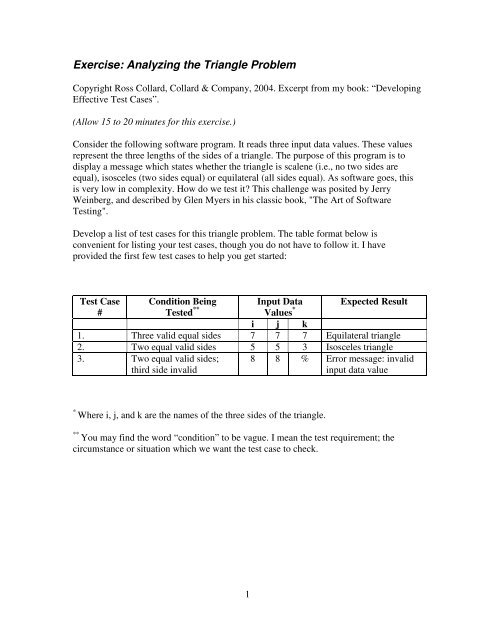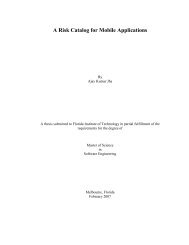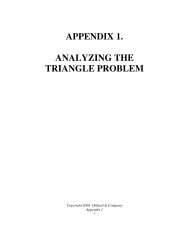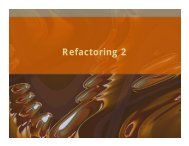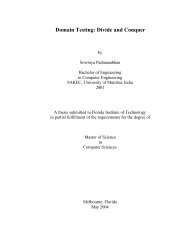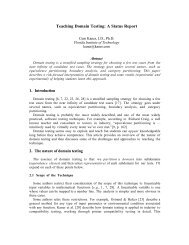Exercise: Analyzing the Triangle Problem - Testing Education
Exercise: Analyzing the Triangle Problem - Testing Education
Exercise: Analyzing the Triangle Problem - Testing Education
Create successful ePaper yourself
Turn your PDF publications into a flip-book with our unique Google optimized e-Paper software.
<strong>Exercise</strong>: <strong>Analyzing</strong> <strong>the</strong> <strong>Triangle</strong> <strong>Problem</strong><br />
Copyright Ross Collard, Collard & Company, 2004. Excerpt from my book: “Developing<br />
Effective Test Cases”.<br />
(Allow 15 to 20 minutes for this exercise.)<br />
Consider <strong>the</strong> following software program. It reads three input data values. These values<br />
represent <strong>the</strong> three lengths of <strong>the</strong> sides of a triangle. The purpose of this program is to<br />
display a message which states whe<strong>the</strong>r <strong>the</strong> triangle is scalene (i.e., no two sides are<br />
equal), isosceles (two sides equal) or equilateral (all sides equal). As software goes, this<br />
is very low in complexity. How do we test it? This challenge was posited by Jerry<br />
Weinberg, and described by Glen Myers in his classic book, "The Art of Software<br />
<strong>Testing</strong>".<br />
Develop a list of test cases for this triangle problem. The table format below is<br />
convenient for listing your test cases, though you do not have to follow it. I have<br />
provided <strong>the</strong> first few test cases to help you get started:<br />
Test Case<br />
#<br />
Condition Being<br />
Tested **<br />
1<br />
Input Data<br />
Values *<br />
Expected Result<br />
i j k<br />
1. Three valid equal sides 7 7 7 Equilateral triangle<br />
2. Two equal valid sides 5 5 3 Isosceles triangle<br />
3. Two equal valid sides;<br />
third side invalid<br />
* Where i, j, and k are <strong>the</strong> names of <strong>the</strong> three sides of <strong>the</strong> triangle.<br />
8 8 % Error message: invalid<br />
input data value<br />
** You may find <strong>the</strong> word “condition” to be vague. I mean <strong>the</strong> test requirement; <strong>the</strong><br />
circumstance or situation which we want <strong>the</strong> test case to check.
Lessons and Conclusions from <strong>the</strong> <strong>Triangle</strong> <strong>Problem</strong><br />
In experiments at IBM and o<strong>the</strong>r organizations, researchers asked experienced systems<br />
professionals to identify an adequate set of test cases for <strong>the</strong> triangle problem. The<br />
researchers gave <strong>the</strong> participants in <strong>the</strong>se experiments unlimited time for this task. The<br />
results of <strong>the</strong>se experiments have been judged to be deplorable: on average, people listed<br />
only about one third of <strong>the</strong> test cases needed for an adequate test. In his book, “Software<br />
<strong>Testing</strong>: A Craftsman’s Approach”, Paul Jorgensen lists about 185 test cases for this<br />
problem. How many did you identify?<br />
I have problems with this "deplorable" interpretation. Adequacy must be assessed with<br />
regard to context. For <strong>the</strong> functionality specified in <strong>the</strong> exercise, I could argue that <strong>the</strong>se<br />
four test cases are sufficient to test adequately:<br />
Test Case Input Values Expected Results<br />
1. 3, 3, 3 Equilateral <strong>Triangle</strong><br />
2. 3, 3, 2 Isosceles <strong>Triangle</strong><br />
3. 3, 4, 5 Scalene <strong>Triangle</strong><br />
4. 3, 3, ? Invalid Input<br />
There are possible defects that would not be detected by this set of four test cases,<br />
however, so o<strong>the</strong>r people may advocate a more thorough test. Kent Beck has written that<br />
he thinks that six test cases would be adequate for his implementation of <strong>the</strong> triangle<br />
problem, and compares this to <strong>the</strong> 65 test cases that Bob Binder describes. This sounds<br />
like a bad joke – ask four different experts, get four different answers which range from<br />
four to 165 test cases – and four consulting bills.<br />
What’s <strong>the</strong> right answer? The answer is that <strong>the</strong>re is no single answer for all<br />
circumstances, as <strong>the</strong> most appropriate answer depends on <strong>the</strong> context. There is a long<br />
history of disservice to business and industry by testers who claim that “adequate” equals<br />
“thorough”. As we saw in Chapter 1, <strong>the</strong> question: "What is <strong>the</strong> correct set of test cases?",<br />
can only be answered in terms of <strong>the</strong> perceived risk in <strong>the</strong> situation and <strong>the</strong> amount of<br />
effort we are willing to expend to avoid that risk. In o<strong>the</strong>r words, <strong>the</strong> right amount of<br />
testing depends on <strong>the</strong> trade-off between <strong>the</strong> risk and economics. If <strong>the</strong> risk is<br />
sufficiently low or <strong>the</strong> cost of testing is sufficiently high, <strong>the</strong> minimal set of four test<br />
cases is adequate. You also may feel that I am playing games by disclosing <strong>the</strong> context<br />
after I asked you to solve <strong>the</strong> problem. You first need to know <strong>the</strong> context before you can<br />
solve <strong>the</strong> triangle problem.<br />
The triangle experiments, where <strong>the</strong> intuitive approach identified only about one third of<br />
<strong>the</strong> test cases, do not prove that <strong>the</strong> intuitive approach doesn't work. The yield of test<br />
cases from systematic analysis can be just as low if <strong>the</strong> information, time and skills are<br />
not available for effective analysis. The experiments do show that test coverage may be<br />
lower than we realize and we need: important test cases are often missed with <strong>the</strong><br />
intuitive approach.<br />
2
What test cases do people miss with <strong>the</strong> triangle problem? In my observation, <strong>the</strong> most<br />
overlooked test case is one with a long side and a couple of short flaps, such as an input<br />
combination of [ 1, 3 and 1 ]. These three lines do not close to form a triangle: to qualify,<br />
<strong>the</strong> sum of any two sides must be greater than <strong>the</strong> third. If <strong>the</strong> system concludes that [ 1, 3<br />
and 1 ] is an isosceles triangle instead of rejecting this combination as invalid, <strong>the</strong><br />
overlooked test case would fail. More than half of <strong>the</strong> participants in <strong>the</strong> experiments do<br />
not identify this test case.<br />
The mis-design of test cases is ano<strong>the</strong>r source of danger. The following example of a misdesigned<br />
test case is based on an ambiguity about triangles. Dictionaries define a triangle<br />
as a body which is enclosed by three straight lines. The word “enclosed” implies that all<br />
six ends of <strong>the</strong> three lines must meet. So this definition addresses whe<strong>the</strong>r <strong>the</strong> triangle<br />
closes and helps us see <strong>the</strong> [ 1, 3 and 1 ] scenario which was previously overlooked.<br />
However, <strong>the</strong>re is an ambiguity in <strong>the</strong> word “body”. If a body is allowed to have no area,<br />
<strong>the</strong>n a test case with an input combination of [ 3, 6 and 3 ] should produce a message<br />
saying this triangle is isosceles, and inputs of [ 1, 2 and 3 ] produce one saying it is<br />
scalene.<br />
Many people argue that <strong>the</strong>se test results are ridiculous. In <strong>the</strong>ir view, test cases with<br />
input data values of [ 1, 2 and 3 ] and [ 3, 6 and 3 ] represent flat lines, not triangles, and<br />
thus <strong>the</strong> system is working correctly if <strong>the</strong>se input combinations are rejected. These<br />
people claim that <strong>the</strong> word “body” implies a contained area which must always be greater<br />
than zero. Since testing is a trade-off of risk and effort, validating this requirement (that<br />
<strong>the</strong> area must exceed zero) is justified only if <strong>the</strong> risk associated with <strong>the</strong> triangle is<br />
sufficiently high. If <strong>the</strong> system includes <strong>the</strong> capability to generate a “Not a triangle” error<br />
message in response to invalid inputs, <strong>the</strong>n <strong>the</strong> corresponding test cases are less likely to<br />
be overlooked: <strong>the</strong> presence of <strong>the</strong> error message prompts us to ask what circumstances<br />
trigger it.<br />
Ano<strong>the</strong>r example of an overlooked test case is more esoteric, but shows <strong>the</strong> lengths we go<br />
to in test case design if <strong>the</strong> risk justifies <strong>the</strong> effort. The software for <strong>the</strong> NASA space<br />
shuttle computes <strong>the</strong> shape of triangles as part of its orbital navigation. (Most image<br />
processing software works with polygons, of which triangles are <strong>the</strong> simplest form.) The<br />
NASA mission is life-critical: if <strong>the</strong> orbital navigation is wrong <strong>the</strong> consequences could<br />
be severe. The triangles computed on <strong>the</strong> space shuttle are curved—<strong>the</strong>y are based on <strong>the</strong><br />
shape of <strong>the</strong> Earth’s surface. Most participants in <strong>the</strong> triangle experiments assume a flat<br />
surface without really thinking about it.<br />
On a curved surface like <strong>the</strong> Earth’s, we could have an input combination of [ 1, 3 and 1 ]<br />
or even [ 1, 300 and 1 ], with <strong>the</strong> long side curving back on itself as it wraps around <strong>the</strong><br />
world. It helps to visualize <strong>the</strong> shape of this “triangle”: it looks like a long narrow strip of<br />
peel cut from <strong>the</strong> top of an orange. Starting at <strong>the</strong> point where <strong>the</strong> stem connects on top of<br />
<strong>the</strong> orange, <strong>the</strong> boundary of <strong>the</strong> piece of peel follows a longitudinal line vertically down<br />
<strong>the</strong> side of <strong>the</strong> orange for one unit of length. Then <strong>the</strong> second side of <strong>the</strong> triangle proceeds<br />
horizontally and circles <strong>the</strong> orange for ano<strong>the</strong>r ten units. The third side proceeds<br />
3
vertically back to <strong>the</strong> top of <strong>the</strong> orange, closing and completing <strong>the</strong> triangle. If <strong>the</strong> three<br />
lines are all “straight” within <strong>the</strong>ir geometry (which is called Riemannian geometry), and<br />
if all six ends of <strong>the</strong> lines meet, <strong>the</strong>n by definition this [ 1, 3 and 1 ] combination is a<br />
valid isosceles triangle on <strong>the</strong> curved surface.<br />
If we allow for <strong>the</strong> possibility of triangles on a curved surface such as a sphere, <strong>the</strong>n <strong>the</strong><br />
only correct result for any possible set of only three inputs is: "Indeterminate -- not<br />
enough data to compute." We will need additional information which indicates whe<strong>the</strong>r<br />
<strong>the</strong> six ends meet or not: not every [ 1, 3 and 1 ] combination of three “straight” lines<br />
forms a triangle on <strong>the</strong> curved surface. To determine if <strong>the</strong> six ends meet, we might also<br />
need to know <strong>the</strong> shape of <strong>the</strong> surface – not all curved surfaces are spheres, and <strong>the</strong> rules<br />
which determine if a triangle closes on a spherical surface do not hold true for all curved<br />
surfaces. Now you know why NASA employs lots of PhDs in ma<strong>the</strong>matics.<br />
GRAPH GOES HERE TO SHOW A GLOBE-ENCIRCLING [ 1, 3, 1 ] TRIANGLE.<br />
If you are not feeling a sense of “gotcha” by now, you should be. I could have introduced<br />
<strong>the</strong> last section by adding <strong>the</strong> possibility of triangles on curved surfaces to <strong>the</strong> previously<br />
stated context, and <strong>the</strong>n asking how <strong>the</strong> new information affects your test cases. Instead I<br />
implied that you were derelict if you overlooked <strong>the</strong> nuances of curved surfaces. Not<br />
telling you <strong>the</strong> full context of a problem, and <strong>the</strong>n expecting you to see every contextdependent<br />
nuance, is unrealistic and unfair. We cannot expect a tester to be omniscient<br />
and find all <strong>the</strong> significant test cases regardless of <strong>the</strong> information she has. Especially<br />
when <strong>the</strong> mission is life-critical, if <strong>the</strong> triangles can occur on curved surfaces <strong>the</strong>n <strong>the</strong><br />
project manager is responsible for ensuring <strong>the</strong> tester has this information. Never<strong>the</strong>less,<br />
<strong>the</strong> tester needs to prompt for information by asking <strong>the</strong> right questions to uncover it.<br />
Rightly or wrongly, usually she is held accountable for any inadvertent omissions in<br />
testing (not including deliberate omissions to meet time and resource limitations).<br />
The ineffective testing of <strong>the</strong> triangle software arises from incomplete analysis,<br />
unrecognized assumptions and vague requirements. The main lesson from <strong>the</strong> triangle<br />
testing experiments is that intuitive testing usually is not enough. In <strong>the</strong> face of poorly<br />
defined requirements, though, intuitive testing may be <strong>the</strong> only approach we’re left with.<br />
We need to be able to recognize when intuitive testing is not sufficient to deliver good<br />
results. Not only do people see only about one third of <strong>the</strong> test cases in <strong>the</strong> triangle<br />
example using intuitive, unstructured techniques, most of <strong>the</strong>se people feel that <strong>the</strong>y had<br />
uncovered 80% or more of <strong>the</strong> test cases. In o<strong>the</strong>r words, an over-confidence in <strong>the</strong><br />
completeness of <strong>the</strong> testing accompanies <strong>the</strong> lack of coverage.<br />
However, mindlessly following <strong>the</strong> test techniques described in this book, and applying<br />
<strong>the</strong>m to typical imperfect specifications, may not be any better than intuitive testing. The<br />
test coverage for <strong>the</strong> triangle software (and by extension, any software), increases<br />
significantly with test case design, but only if three conditions are met:<br />
4
1. The testers have a clear, correct, complete and unambiguous feature specification,<br />
plus access to one or more knowledgeable persons who can authoritatively answer<br />
questions about <strong>the</strong> feature.<br />
2. The testers are methodically trained to analyze features and derive test cases,<br />
using <strong>the</strong> techniques which are explained in this book.<br />
3. The testers have sufficient time to do <strong>the</strong> work. The testers in <strong>the</strong> triangle<br />
experiment were given unlimited time, so that having <strong>the</strong> time available is not<br />
sufficient by itself to ensure adequate coverage. And in reality, many testers are<br />
pressured by tight deadlines and resource limits.<br />
When <strong>the</strong>se conditions are met, <strong>the</strong> test coverage, <strong>the</strong> count of detected bugs (weighted<br />
by severity), and <strong>the</strong> test efficiency (bugs found per hour) often increase dramatically.<br />
Admittedly, <strong>the</strong>se benefits are not free -- <strong>the</strong> test preparation effort also increases. But my<br />
experience is that <strong>the</strong> extra effort pays off on most projects.<br />
5


